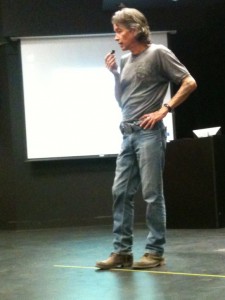Archives
Author Archive
July 26, 2014
Wednesday.
“Make It Blog” Pound famously ordered, and Kailin expounded the weight of the decree: Publish Or I’ll Perish You (though perhaps I exaggerate).
The famous EMiC blog! The weblog. We-be-loggin #TEMiC2014, on a day-to-day schedule.
In the naivety of Monday I assumed that signing up for Wednesday’s scheduled blog-entry would leave me plenty of time to absorb some of the ample brilliance on display and spin it into the requisite 500 words, all before a quick swim in Okanagan Lake with Carl. But now it’s Friday and, as Rebecca Black always said, gotta get it done on Friday (especially important advice given that The Way Back Machine is very poorly named indeed (though still impressive)).
Somehow the week disappeared into a blur of stimulating seminars, delicious lunches, outstanding plenary speakers, wonderful workshops, adventurous automobiling, dinner-and-drinks(+), and late-night debates about the potential existence of a man named Marcel Duchamp (hint: he’s a real thing and an enthusiastic scrap-booker). Should I still write about Wednesday, as I promised all those other days ago? Should I attempt to remediate the performance of the day onto The Famous EMiC blog!, striving in vain for an authentic representation of the immediacy and original intention of all those users/actors/readers/writers/performers/speakers/places/materialities/bibliographies/double- and triple-helixed codes of hump or slump day? I’d try but my notes blew out of the car’s window on my drive over here and I don’t think that Karis had that webcam running and there don’t seem to be any recordings of the day on PennSound or SpokenWeb or YouTube. Anyway: Onward!
Tuesday morning I talked about the WatsonWalk app, which I worked on with the EMiC UA group. Our earlier discussion of archives and projects Tuesday had turned towards the importance of collaboration and Dean had argued that most people need to be taught how to collaborate—it’s not an automatic process that leaps successfully from a group. Dean’s point is a good one and I added to it only that people need instruction not just in general ideas or theories of collaboration as an abstract notion but also in practical specifics of collaboration: how can a team meet most productively, how does work material circulate (on-line or off), who keeps track of what’s happening (documentation), how does the workflow change, etc.? The collaboration that emerged around the WatsonWalk app was shaped by the humility and generosity of all the participants, especially Paul and Harvey, the project leaders. Projects without such patient leadership and without training in collaboration undoubtedly produce the horror-stories that emerge all too often in which collaboration degenerates into the hierarchical allocation of labour. Building on Julia’s earlier points about the importance of art and design in digital projects, I also noted that collaboration with artists and designers needs to happen from the initial stages of any dh project. Literary scholars generally aren’t very good at graphic design and programmers generally think that the blinking green text of the command line is pretty enough. Including a designer from the outset saves time, money, and effort. I talked also about the content of the WatsonWalk app, but that’s been done elsewhere and the best way to see how it works and what it contains is to download and play with it!
But that was Tuesday, not my Wednesday. Wednesday afternoon Paul Seesequasis, editor-in-chief of Theytus Books in Penticton, visited to talk about Big Bear, Queen Victoria, difficulties of translation, tricksters, scholarly depictions of “The Canadian Indian,” and tongues planted firmly in cheeks. In the morning seminar we had discussed, among other things, the nature of “the oral” and “oralities,” and the difficulty of shoe-horning all types of oral performance into systems designed to manage textual material. If textual artefacts are subject to the double-helix of linguistic and bibliographic codes, as McGann convincingly argues, what words do we have for describing the codes that govern texts that are distinctly non-textual—not bibliographic—including oralities and a range of other “performances”? Borrowing from Genette’s notion of the paratext, how about paraformance? Oral texts as structured by a double-helix of linguistic and paraformative codes? I like it.

The paraformative elements of Seesequasis’s plenary included a wry smile, a big belt-buckle, and an unreliable lapel mic held in his sometimes-waving hands, which meant that his voice came and went and there were gaps in his speech to be minded. Was he, even then, hiding the good stuff in those gaps? Was he performing a tricky sleight-of-hand as he fumbled through the unhelpfully named images on his computer, searching for the right one, reminding that he could have used PowerPoint but didn’t—was there another story being told in the repeated opening and closing of the images we’d already seen or somewhere on the desktop in the background? Was he teaching us the pleasure of frustration as he showed us those guys on the golf course again and again? Someone asked about humour and he said that situations that lack humour are generally bad ones.
A trickster must have installed this handrail off the stage:
Wednesday evening many of us put into practice all we’d learned about oral remediation as we sat around talking, telling stories of varying pertinence and volume, and as we talked we and our stories grew a bit fuzzy around the edges and the cheeks of our stories may have glowed a little but campus security didn’t seem to mind, yet. And out of Wednesday, and all the other days, wonderful connections developed between the participants of TEMiC 2014—collaborative projects, intellectual exchanges, and, I’m sure, lasting friendships.
I thoroughly enjoyed UBCO and a great many thanks to everyone in attendance and to Karis, Dean, Cole, and everyone else involved in organizing the week—or at least in organizing up to Wednesday: I wouldn’t want to step on the toes of whomever was press-ganged into remediating Thursday and Friday…
